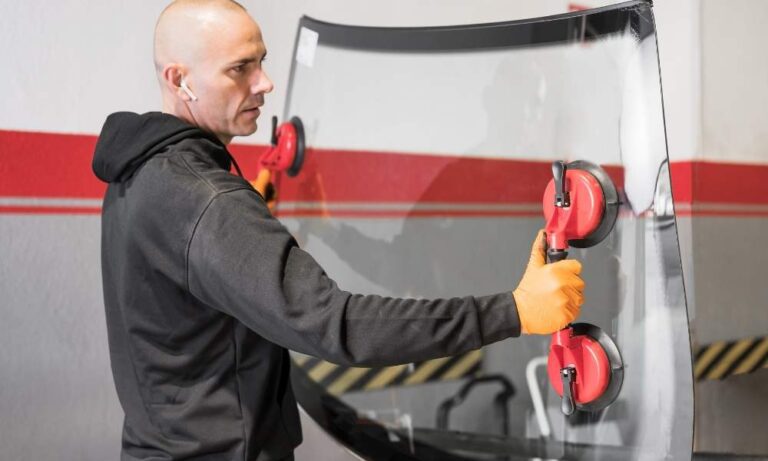In this blog post, we will delve deeper into the...
The Environmental Impact of Auto Glass: Recycling and Sustainability Efforts

In today’s world, the quest for sustainability and environmental consciousness is more crucial than ever before. As we navigate the challenges posed by climate change and dwindling natural resources, every industry must take responsibility for its environmental impact.
The automotive sector, a major contributor to pollution and waste, is no exception. One often overlooked component of vehicles with significant environmental implications is auto glass. This blog aims to shed light on the environmental impact of auto glass and explore the recycling and sustainability efforts that are shaping a greener future for the industry.
The Environmental Footprint of Auto Glass
Auto glass, comprising windshields, side windows, and rear windows, plays a vital role in vehicle design, providing structural integrity, visibility, and protection. However, the production, use, and disposal of auto glass come with a notable environmental footprint.
1. Raw Material Extraction:
Traditional auto glass is primarily made from laminated glass, which consists of layers of glass and plastic interlayers. The extraction of raw materials, such as sand and silica for glass and petroleum-based plastics for interlayers, contributes to habitat destruction, soil erosion, and water pollution. These extraction processes can disrupt ecosystems and impact local communities.
2. Energy Consumption and Emissions:
The manufacturing process for auto glass involves high-energy consumption, which often relies on non-renewable fossil fuels. Additionally, the production of glass and plastics emits greenhouse gasses, contributing to global warming and air pollution.
3. Waste Generation:
When a vehicle with damaged or outdated auto glass is retired, the glass often ends up in landfills. Unlike other vehicle components, auto glass is not biodegradable and can take hundreds of years to break down. This waste generation exacerbates the strain on already burdened landfill sites.
4. Safety Concerns:
Proper auto glass design and installation are critical for passenger safety. Inadequate disposal or recycling practices can result in unsafe reuse or improper disposal, potentially leading to accidents and injuries.
Recycling and Sustainability Efforts
Thankfully, the automotive industry is gradually recognizing the importance of sustainable practices and is taking steps to mitigate the environmental impact of auto glass. Here are some notable recycling and sustainability efforts that are shaping the future of auto glass production and disposal:
Windshield Recycling Programs:
Many companies and organizations have initiated windshield recycling programs to divert used auto glass away from landfills. These programs involve collecting and processing discarded windshields to recover the glass and plastics for reuse in various industries, such as construction and manufacturing.
Innovations in Glass Technology:
Researchers and manufacturers are exploring innovative glass technologies to reduce the environmental impact. For example, using thinner glass and advanced interlayer materials can decrease the weight of auto glass, leading to improved fuel efficiency and reduced emissions over the vehicle’s lifespan.
Closed-Loop Systems:
Some manufacturers have implemented closed-loop systems where they collect, recycle, and reintegrate their own auto glass waste back into their production processes. This circular approach reduces the need for virgin raw materials and minimizes waste generation.
Collaboration and Partnerships:
Industry collaborations and partnerships are crucial for driving sustainable change. Auto manufacturers, glass producers, and recycling facilities are working together to develop efficient recycling methods, promote responsible disposal practices, and share best practices.
Advancements in Glass Separation Technology:
Recycling laminated auto glass has historically been challenging due to the fusion of glass and plastic layers. However, advancements in separation technologies are making it increasingly feasible to recover both materials, enabling higher recycling rates.
Consumer Education:
Raising awareness among consumers about the environmental impact of auto glass and the importance of responsible disposal can encourage proper recycling practices. Educated consumers are more likely to demand sustainable alternatives and hold manufacturers accountable for their environmental practices.
The Benefits and Future Outlook?
The efforts towards recycling and sustainability in the auto glass industry yield numerous benefits for the environment, the economy, and society as a whole:
1. Reduced Raw Material Consumption:
Increased recycling rates and the use of recycled materials in auto glass production reduce the demand for virgin raw materials, conserving natural resources and minimizing habitat destruction.
2. Energy and Emission Reduction:
By recycling auto glass and adopting more energy-efficient manufacturing processes, the industry can significantly decrease its energy consumption and greenhouse gas emissions, contributing to global efforts to combat climate change.
3. Economic Opportunities:
The development of recycling infrastructure and the adoption of sustainable practices create economic opportunities, including job creation in recycling facilities, research and development of innovative technologies, and the growth of a circular economy.
4. Improved Public Health:
Reducing waste generation and limiting the release of harmful emissions from auto glass production contribute to improved air and water quality, benefiting the health and well-being of communities.
5. Positive Brand Image:
Auto manufacturers and glass producers that prioritize sustainability can enhance their brand image, attract environmentally-conscious consumers, and differentiate themselves in a competitive market.
Looking ahead, the auto glass industry must continue to embrace sustainability as a core value. This entails further research and development of innovative technologies, increased collaboration among stakeholders, and ongoing consumer education. By doing so, the industry can play a pivotal role in reducing the environmental impact of vehicles and contribute to a more sustainable future.
Conclusion
The environmental impact of auto glass is a pressing concern that demands attention and action from all stakeholders. As the automotive industry grapples with the challenges of sustainability, addressing the issues associated with auto glass production and disposal is a crucial step toward reducing the sector’s environmental footprint.
The adoption of recycling initiatives, the development of innovative technologies, and a commitment to responsible practices are all contributing to a more sustainable future for auto glass. By recognizing the potential of these efforts and supporting the shift toward greener practices, we can drive positive change and create a lasting impact on the environment, the economy, and society as a whole.
Read more Articles
Signs It’s Time to Replace Your Auto Glass: Cracks, Chips, and Beyond
In this blog post, we will delve deeper into the...


